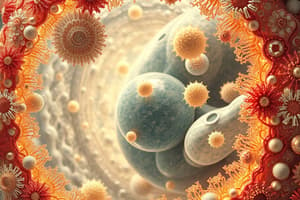Podcast
Questions and Answers
What happens to LDL after it is internalized by the cell?
What happens to LDL after it is internalized by the cell?
How does LDL dissociate from its receptors?
How does LDL dissociate from its receptors?
What is the primary fate of LDL receptors after they dissociate from LDL?
What is the primary fate of LDL receptors after they dissociate from LDL?
How often does an LDL receptor make a round trip into the cell and back?
How often does an LDL receptor make a round trip into the cell and back?
Signup and view all the answers
During its lifespan, how long does an LDL receptor typically remain functional before being recycled?
During its lifespan, how long does an LDL receptor typically remain functional before being recycled?
Signup and view all the answers
What directs ribosomes in the cytosol to the ER?
What directs ribosomes in the cytosol to the ER?
Signup and view all the answers
Which type of proteins pass completely into the ER lumen?
Which type of proteins pass completely into the ER lumen?
Signup and view all the answers
What initiates the translocation process of ribosomes into the ER membrane?
What initiates the translocation process of ribosomes into the ER membrane?
Signup and view all the answers
What is the primary function of transport vesicles?
What is the primary function of transport vesicles?
Signup and view all the answers
Which pathway describes the transport of synthesized proteins to the plasma membrane?
Which pathway describes the transport of synthesized proteins to the plasma membrane?
Signup and view all the answers
Where do extracellular molecules ingested by the cell go first?
Where do extracellular molecules ingested by the cell go first?
Signup and view all the answers
What remains anchored in the lipid bilayer during the translocation process?
What remains anchored in the lipid bilayer during the translocation process?
Signup and view all the answers
What does vesicular transport within the endomembrane system rely on?
What does vesicular transport within the endomembrane system rely on?
Signup and view all the answers
What is one of the primary functions of membrane-enclosed organelles in eukaryotic cells?
What is one of the primary functions of membrane-enclosed organelles in eukaryotic cells?
Signup and view all the answers
Which organelle is considered the most prominent in eukaryotic cells?
Which organelle is considered the most prominent in eukaryotic cells?
Signup and view all the answers
How do eukaryotic cells communicate between their internal membranes and the cytosol?
How do eukaryotic cells communicate between their internal membranes and the cytosol?
Signup and view all the answers
What major site is primarily responsible for the synthesis of new membranes in eukaryotic cells?
What major site is primarily responsible for the synthesis of new membranes in eukaryotic cells?
Signup and view all the answers
What is one consequence of mixing the contents of eukaryotic cells in a test tube?
What is one consequence of mixing the contents of eukaryotic cells in a test tube?
Signup and view all the answers
Which of the following describes the arrangement of reactions in eukaryotic cells?
Which of the following describes the arrangement of reactions in eukaryotic cells?
Signup and view all the answers
Which of the following is NOT a strategy used by cells to organize metabolic processes?
Which of the following is NOT a strategy used by cells to organize metabolic processes?
Signup and view all the answers
What typically arises if the contents of liver cells are mixed in vitro?
What typically arises if the contents of liver cells are mixed in vitro?
Signup and view all the answers
What determines the fate of receptor proteins involved in endocytosis?
What determines the fate of receptor proteins involved in endocytosis?
Signup and view all the answers
Which of the following pathways lead materials to the lysosome?
Which of the following pathways lead materials to the lysosome?
Signup and view all the answers
What is formed when an organelle is enclosed by a double membrane during autophagy?
What is formed when an organelle is enclosed by a double membrane during autophagy?
Signup and view all the answers
What type of endocytic pathway results in receptor recycling to the same plasma membrane?
What type of endocytic pathway results in receptor recycling to the same plasma membrane?
Signup and view all the answers
Which component of the lysosome contributes to the degradation process?
Which component of the lysosome contributes to the degradation process?
Signup and view all the answers
What is the role of the signal sequence in mitochondrial protein import?
What is the role of the signal sequence in mitochondrial protein import?
Signup and view all the answers
What distinguishes membrane-bound ribosomes from free ribosomes?
What distinguishes membrane-bound ribosomes from free ribosomes?
Signup and view all the answers
How does the Signal-Recognition Particle (SRP) affect protein synthesis?
How does the Signal-Recognition Particle (SRP) affect protein synthesis?
Signup and view all the answers
What is one of the primary functions of chaperone proteins in mitochondrial import?
What is one of the primary functions of chaperone proteins in mitochondrial import?
Signup and view all the answers
Which of the following statements about the endoplasmic reticulum (ER) is accurate?
Which of the following statements about the endoplasmic reticulum (ER) is accurate?
Signup and view all the answers
What happens to ribosomal subunits after a round of protein synthesis?
What happens to ribosomal subunits after a round of protein synthesis?
Signup and view all the answers
What characterizes the structure of the endoplasmic reticulum in eukaryotic cells?
What characterizes the structure of the endoplasmic reticulum in eukaryotic cells?
Signup and view all the answers
Which feature is specific to rough endoplasmic reticulum?
Which feature is specific to rough endoplasmic reticulum?
Signup and view all the answers
Study Notes
Intracellular Compartments and Protein Transport
- Eukaryotic cells segregate different metabolic processes within different membrane-enclosed compartments.
- This allows for more efficient and organized chemical reactions within the cell.
- Membrane-enclosed compartments are called organelles.
Organelles
- The nucleus is the most prominent organelle, containing the cell's genetic material.
- The endoplasmic reticulum (ER) is the site of new membrane synthesis.
- The Golgi apparatus processes and distributes proteins synthesized in the ER.
- Lysosomes are involved in the breakdown of macromolecules.
- Mitochondria are the powerhouses of the cell, responsible for ATP production.
- Peroxisomes contain enzymes that break down fatty acids and other molecules.
Protein Transport
- Proteins destined for the ER, Golgi apparatus, lysosomes, or secretion are synthesized on ribosomes attached to the ER membrane.
- Proteins contain an ER signal sequence that directs them to the ER.
- The signal-recognition particle (SRP) binds to the signal sequence and the ribosome, slowing protein synthesis.
- The SRP-ribosome complex binds to an SRP receptor on the ER membrane.
- The ribosome docks with a protein translocator in the ER membrane.
- The protein is translocated across the ER membrane.
- The signal sequence is cleaved off by a signal peptidase inside the ER lumen.
Vesicular Transport
- Transport vesicles carry soluble proteins and membranes between cell compartments.
- The secretory pathway transports newly synthesized proteins from the ER to the Golgi apparatus, plasma membrane, and lysosomes.
- The endocytic pathway brings extracellular molecules into the cell by engulfing them in vesicles derived from the plasma membrane.
- These vesicles fuse with endosomes and eventually lysosomes for degradation.
Receptor-Mediated Endocytosis
- LDL (low-density lipoprotein) binds to LDL receptors on the cell surface.
- The LDL-receptor complex is internalized in clathrin-coated vesicles.
- The vesicles lose their coat and fuse with endosomes.
- The LDL dissociates from its receptor in the acidic environment of the endosome.
- LDL is degraded in lysosomes, releasing free cholesterol.
- LDL receptors are recycled back to the plasma membrane.
Lysosomes
- Lysosomes contain hydrolytic enzymes that degrade macromolecules.
- They maintain an acidic pH, optimal for the activity of their enzymes.
Autophagy
- Autophagy is the process of degrading obsolete parts of the cell itself.
- An organelle is enclosed by a double membrane, forming an autophagosome.
- The autophagosome fuses with a lysosome, and the contents are degraded.
Summary
- Eukaryotic cells have developed a system of membrane-enclosed organelles to compartmentalize different metabolic processes.
- Proteins destined for different organelles are synthesized on ribosomes attached to the ER membrane.
- Vesicular transport carries proteins and membranes between cell compartments.
- Receptor-mediated endocytosis is a mechanism by which cells take up specific molecules from the extracellular environment.
- Lysosomes are responsible for the degradation of macromolecules and cellular components through autophagy.
Studying That Suits You
Use AI to generate personalized quizzes and flashcards to suit your learning preferences.
Related Documents
Description
Test your knowledge on eukaryotic cells and their organelles. This quiz covers various cell compartments, their functions, and the process of protein transport within these organelles. Perfect for biology students aiming to understand cellular organization.




